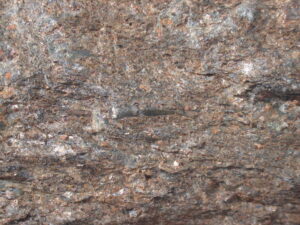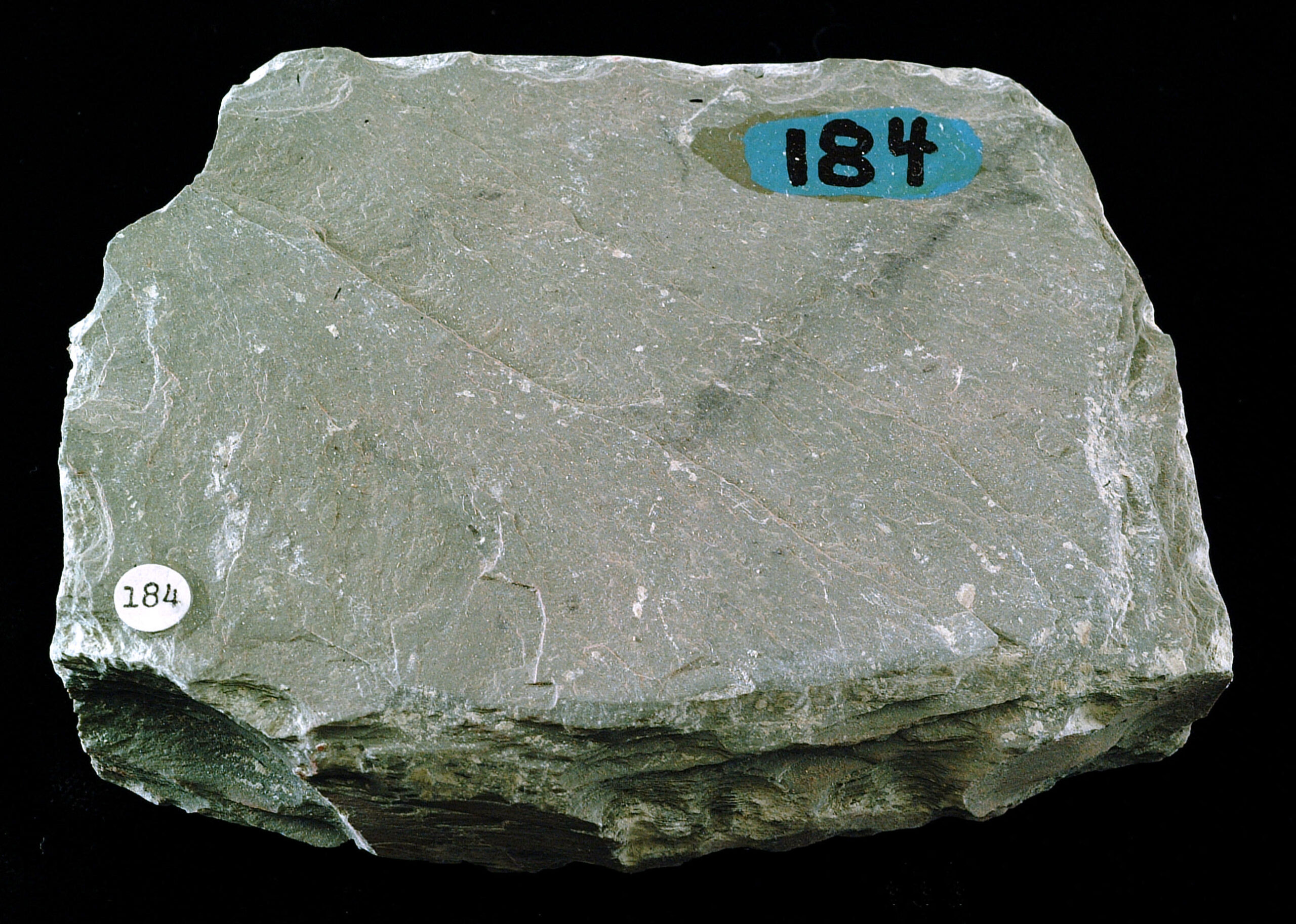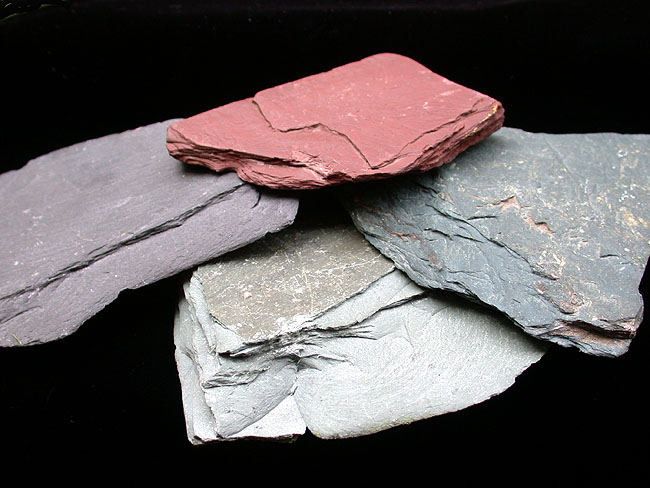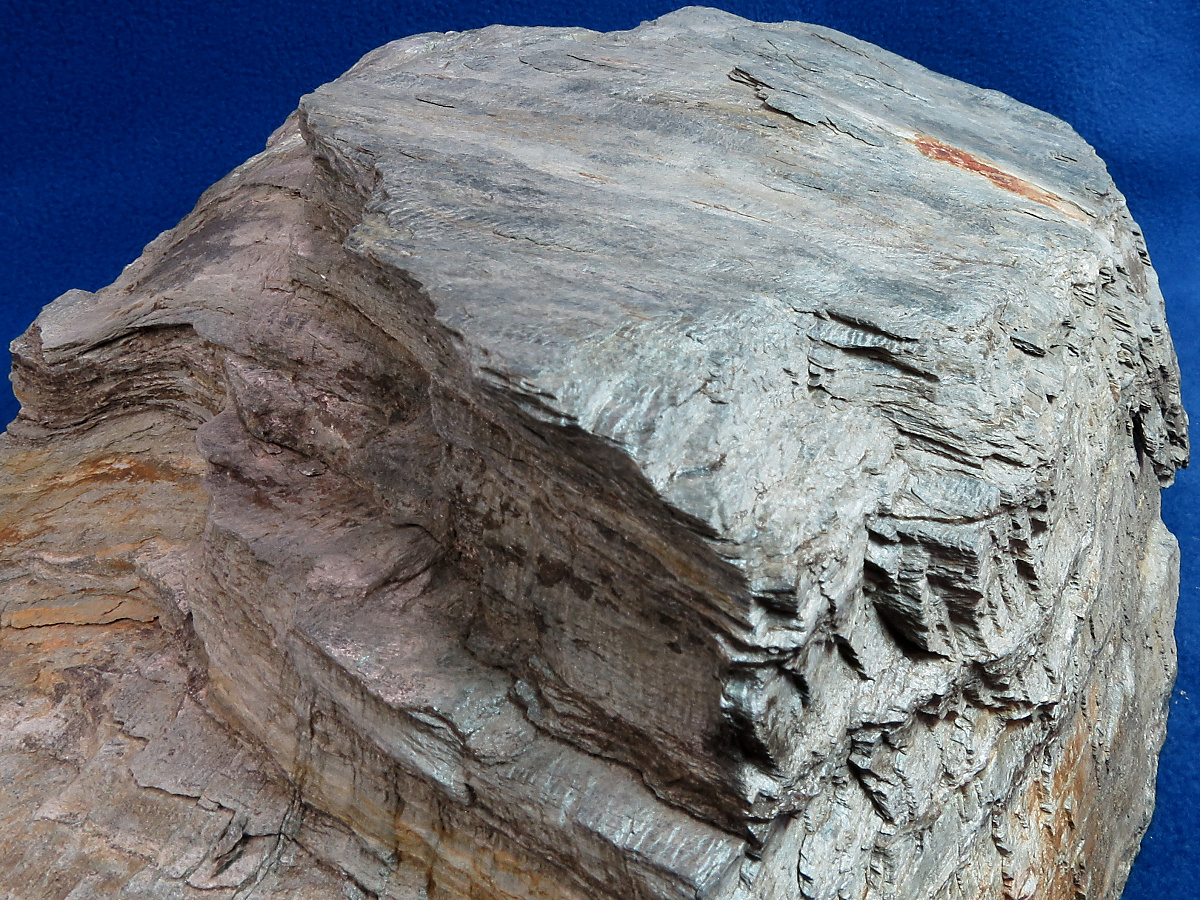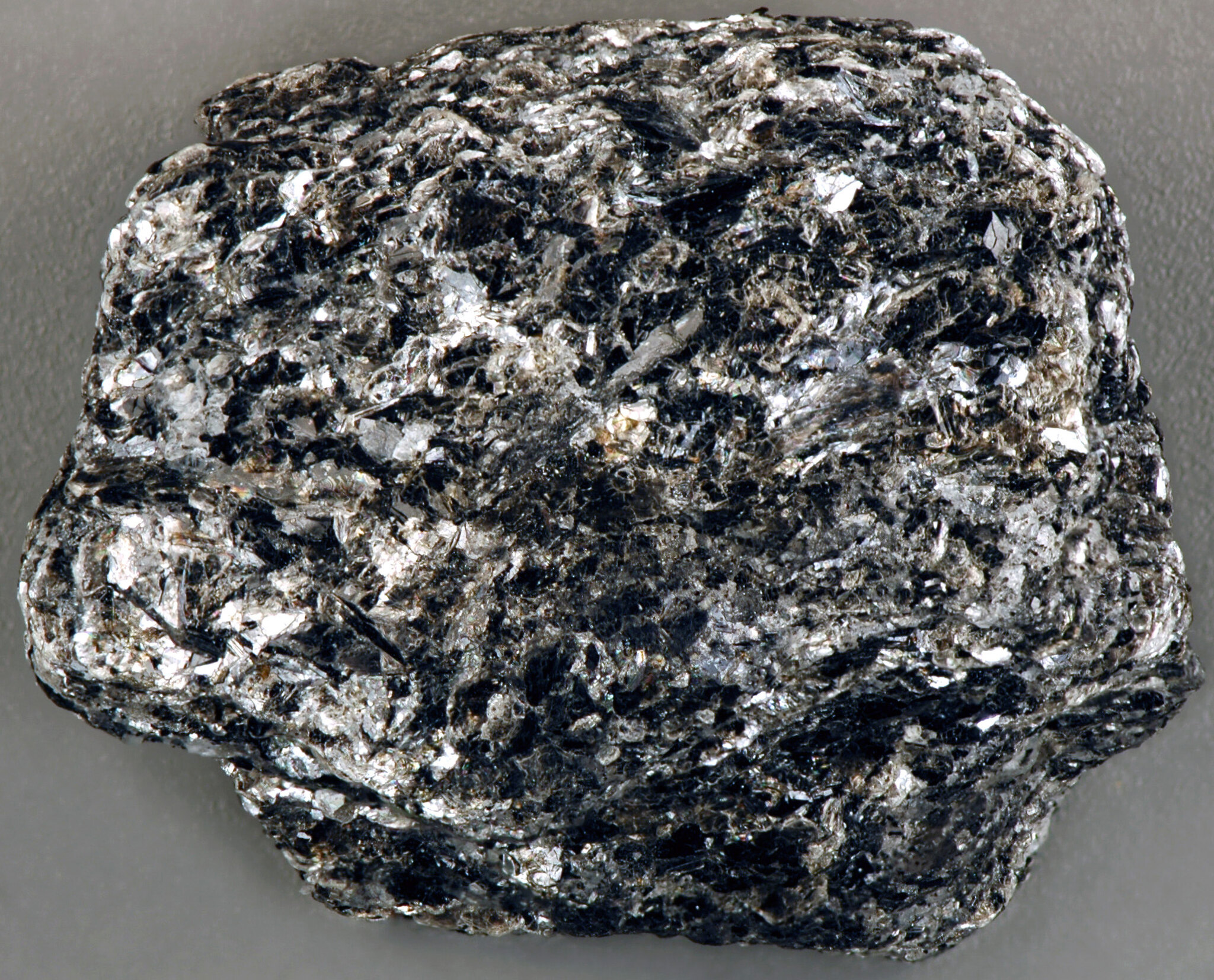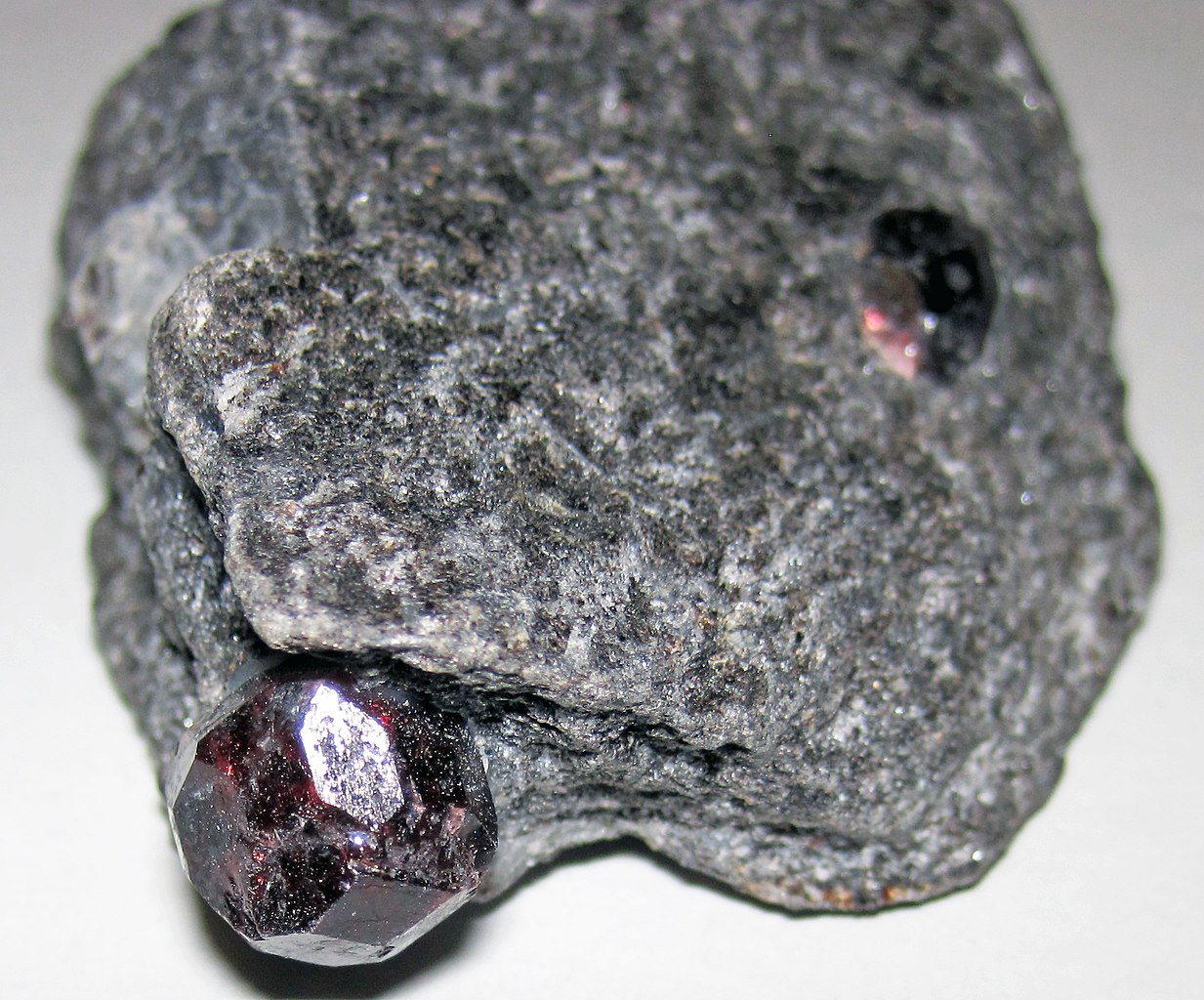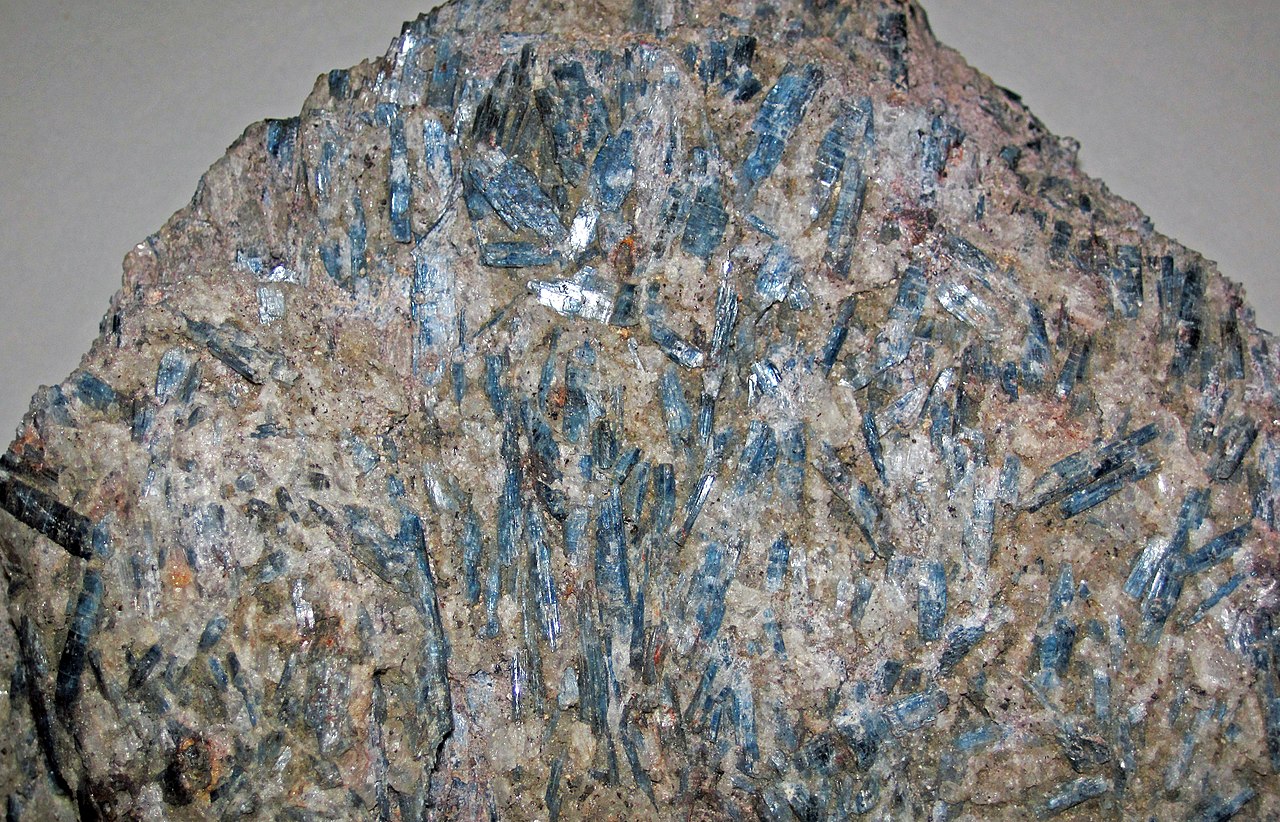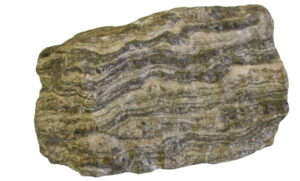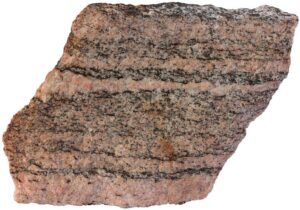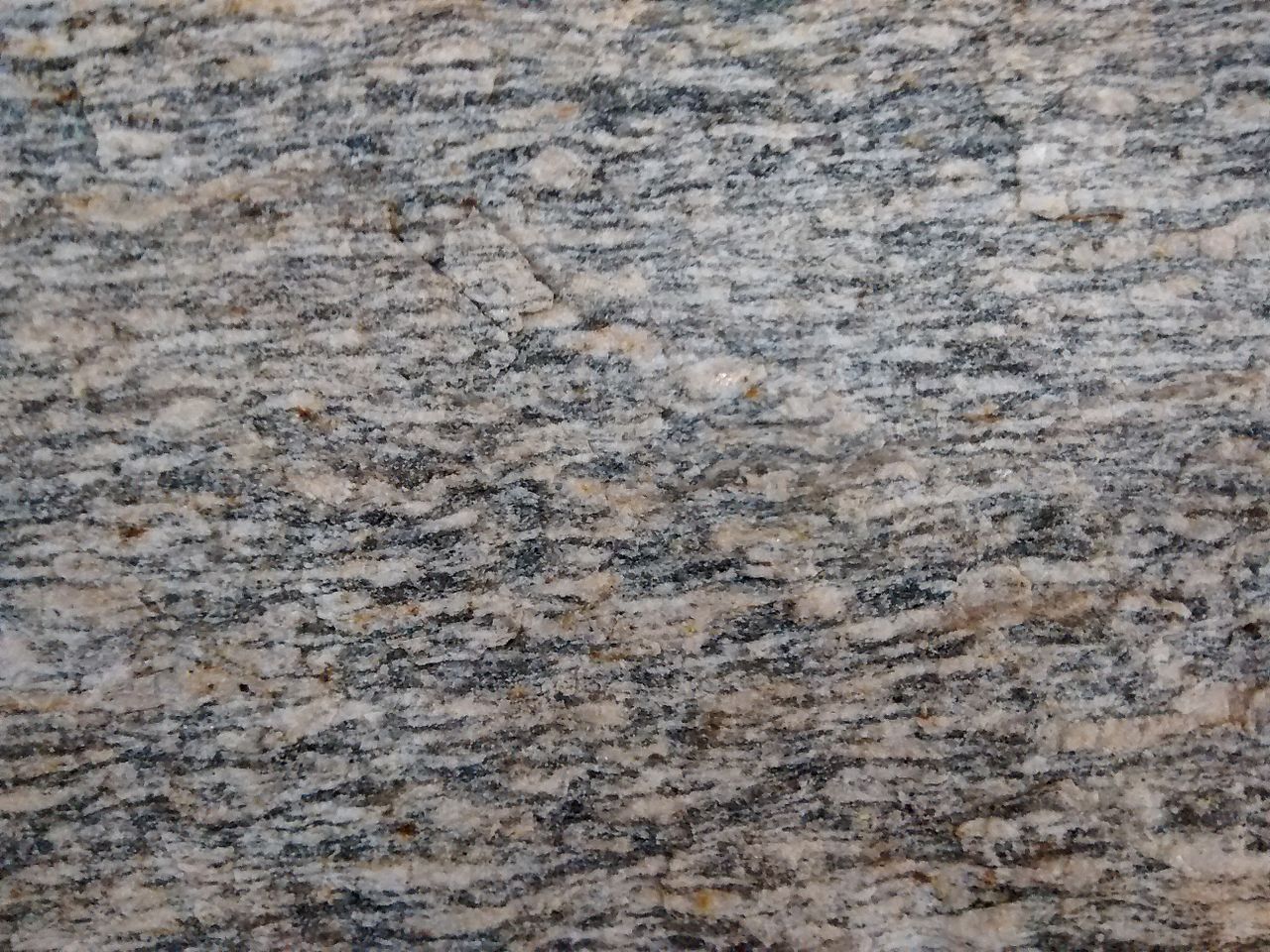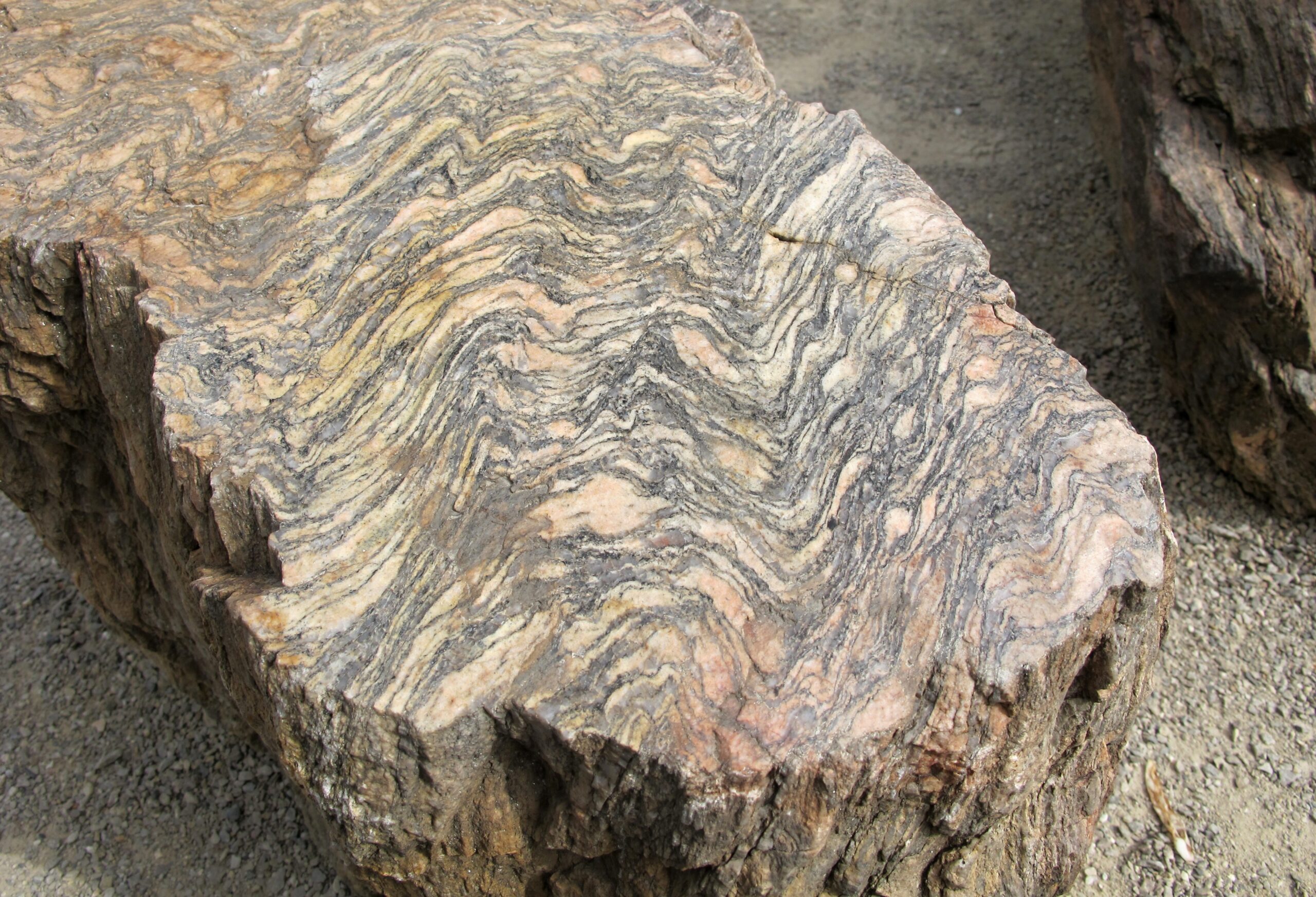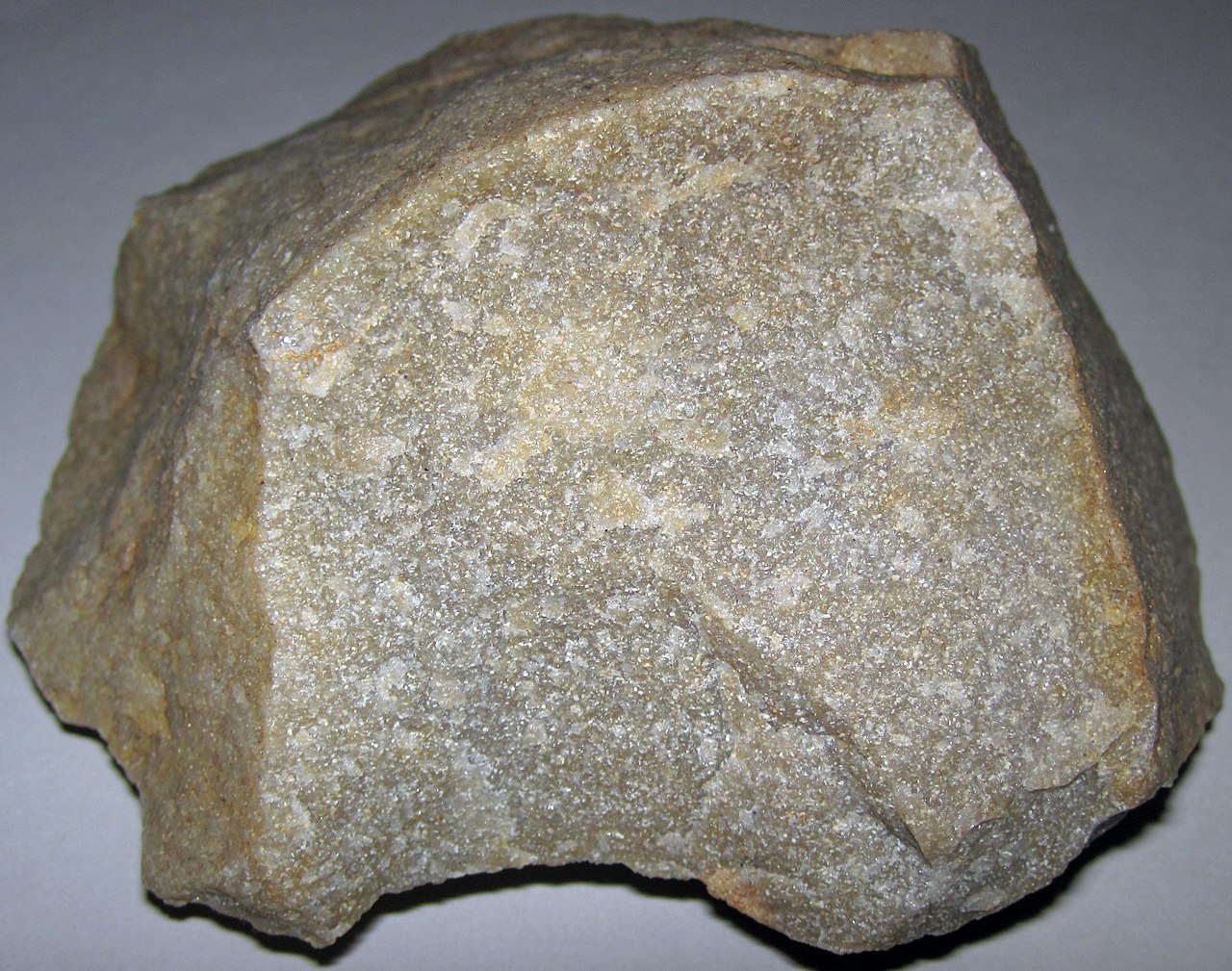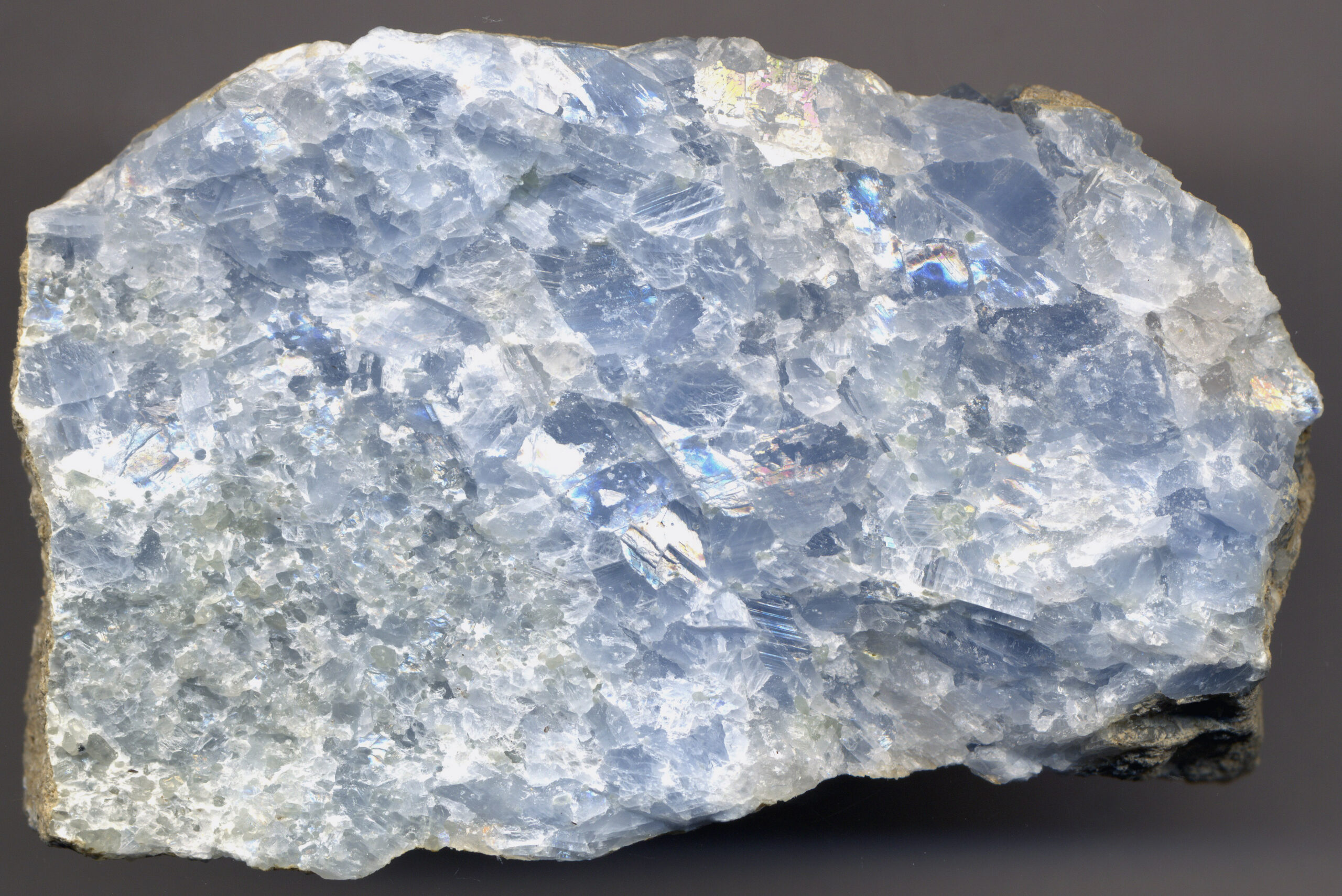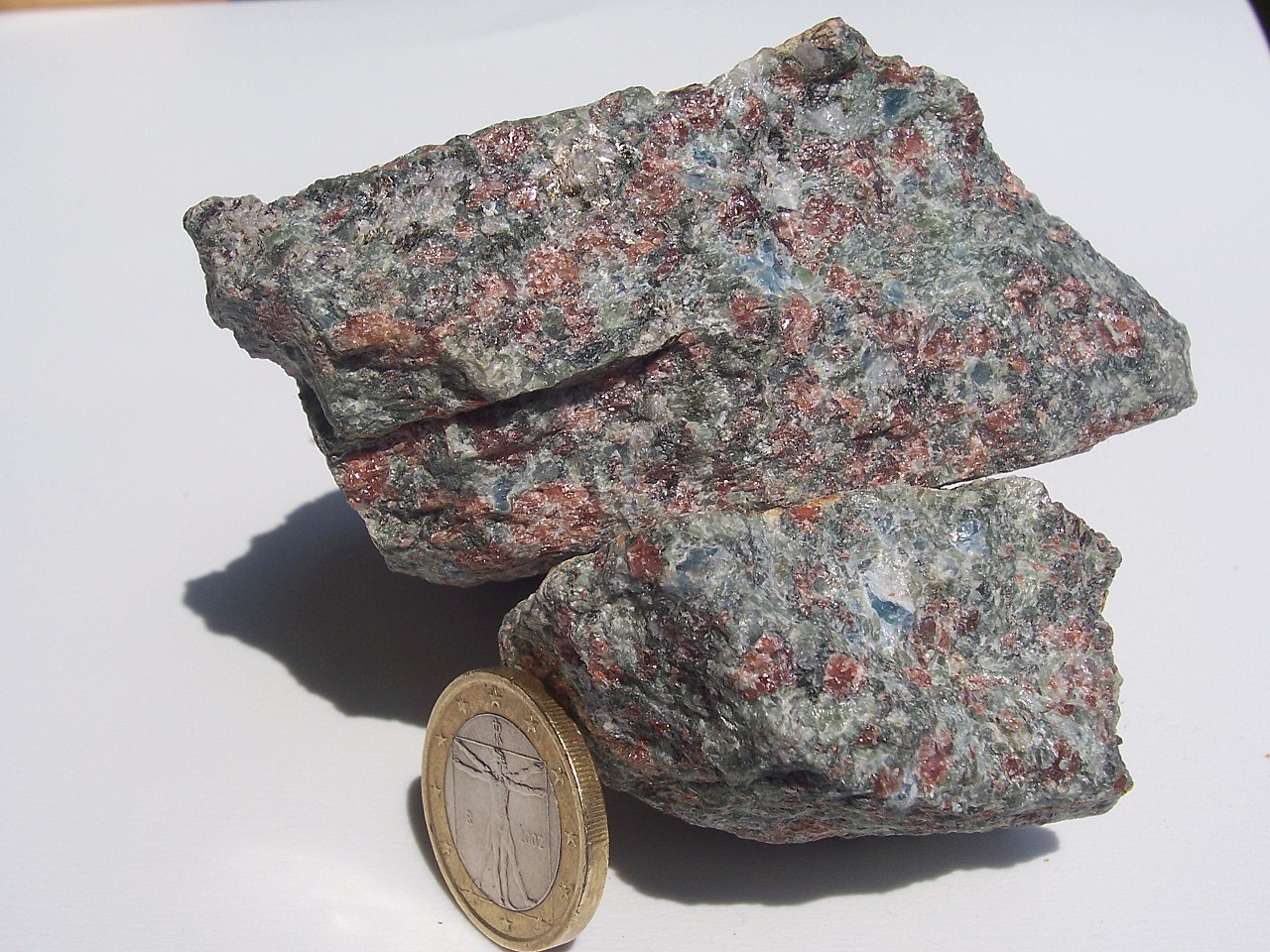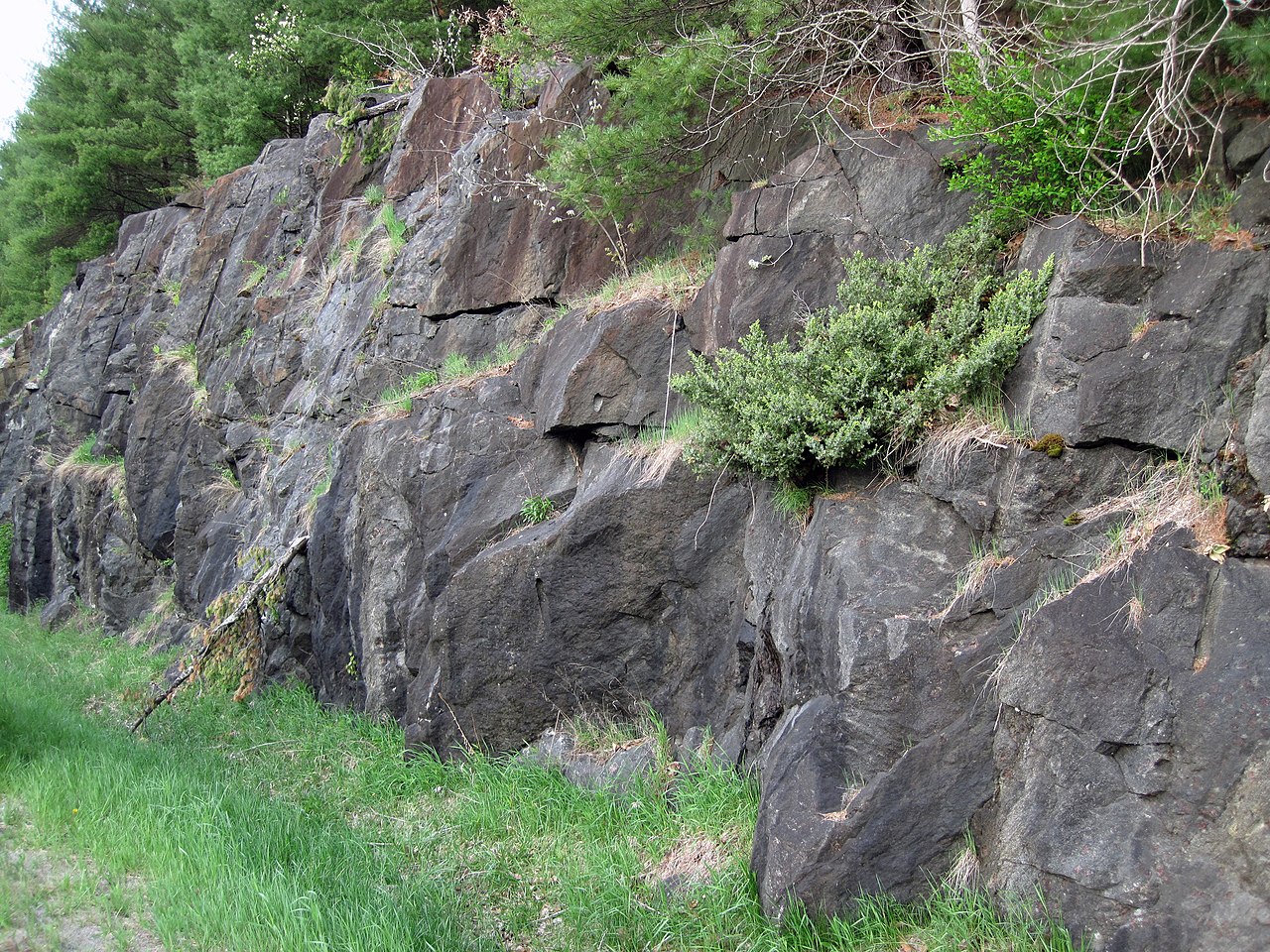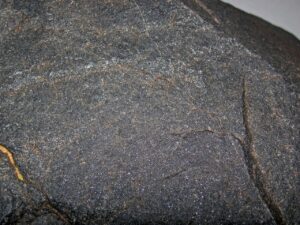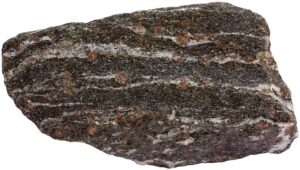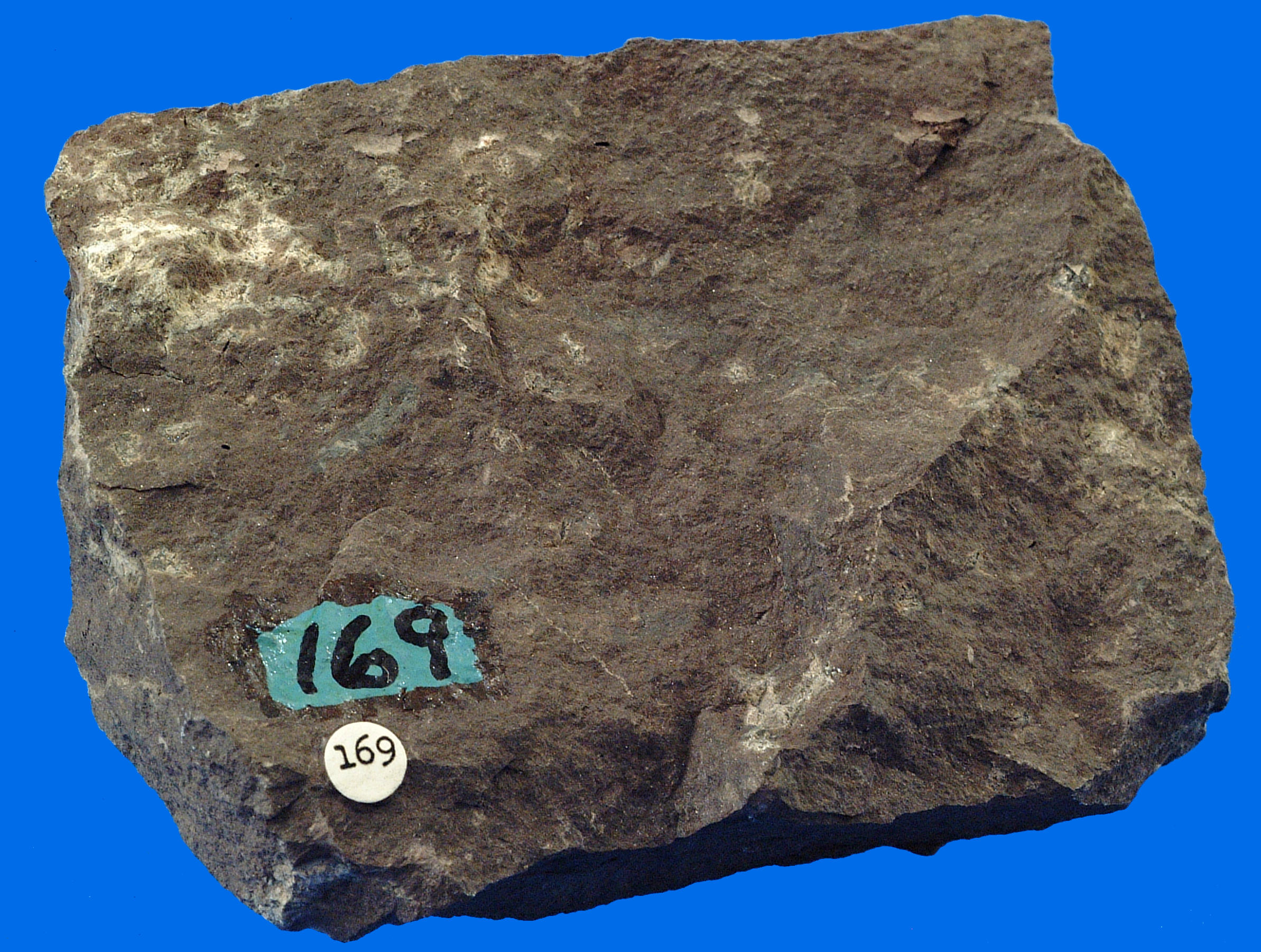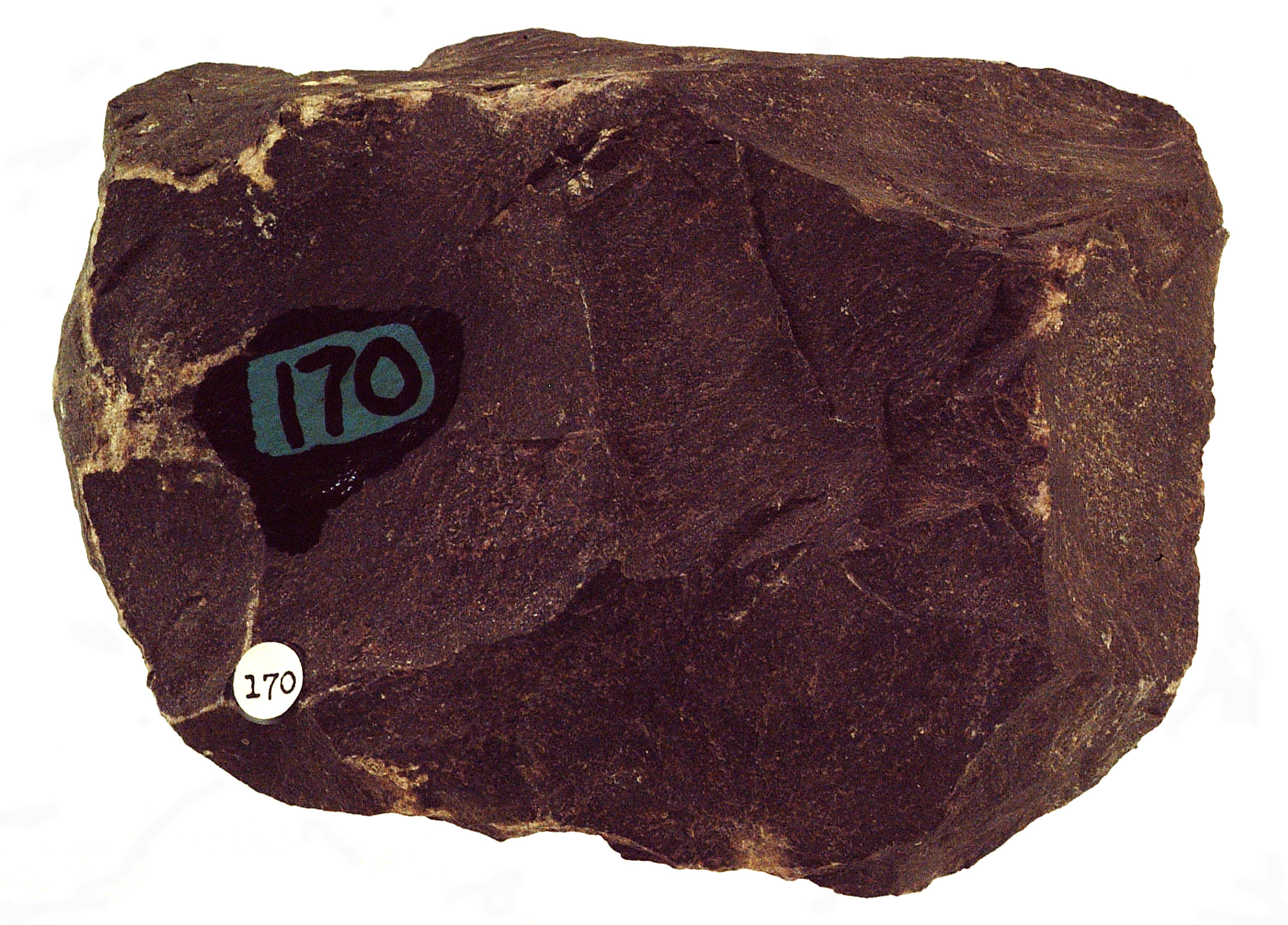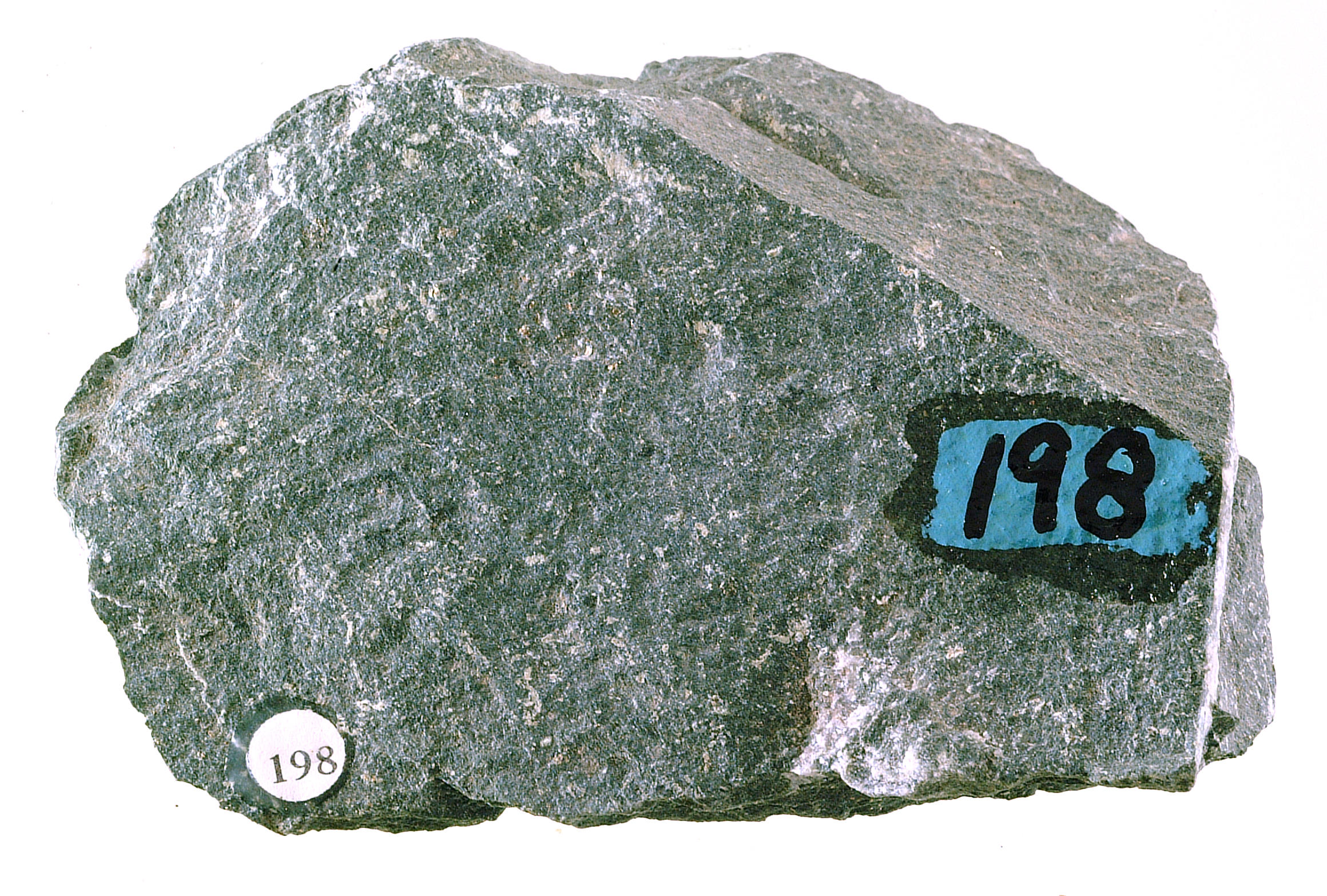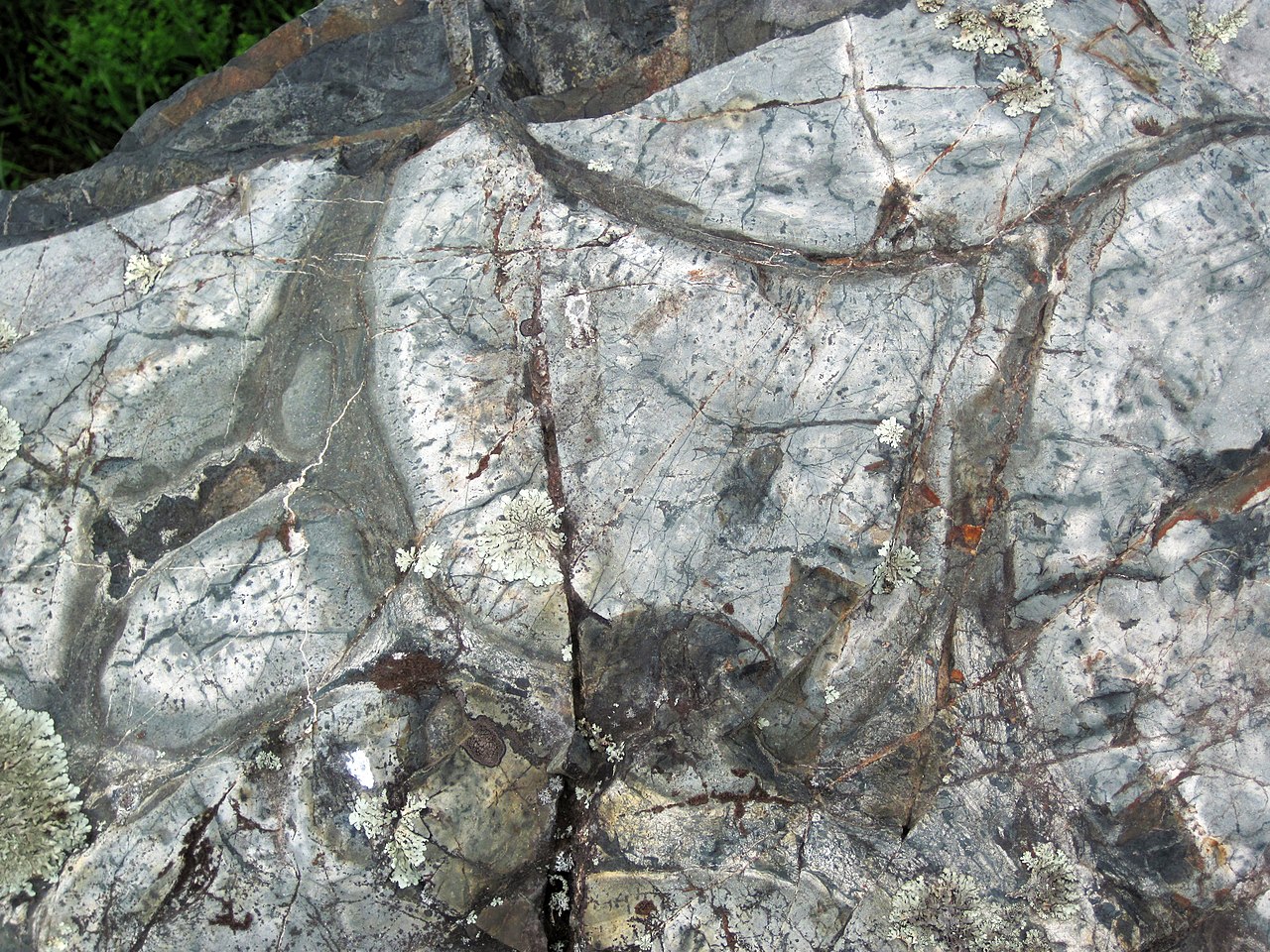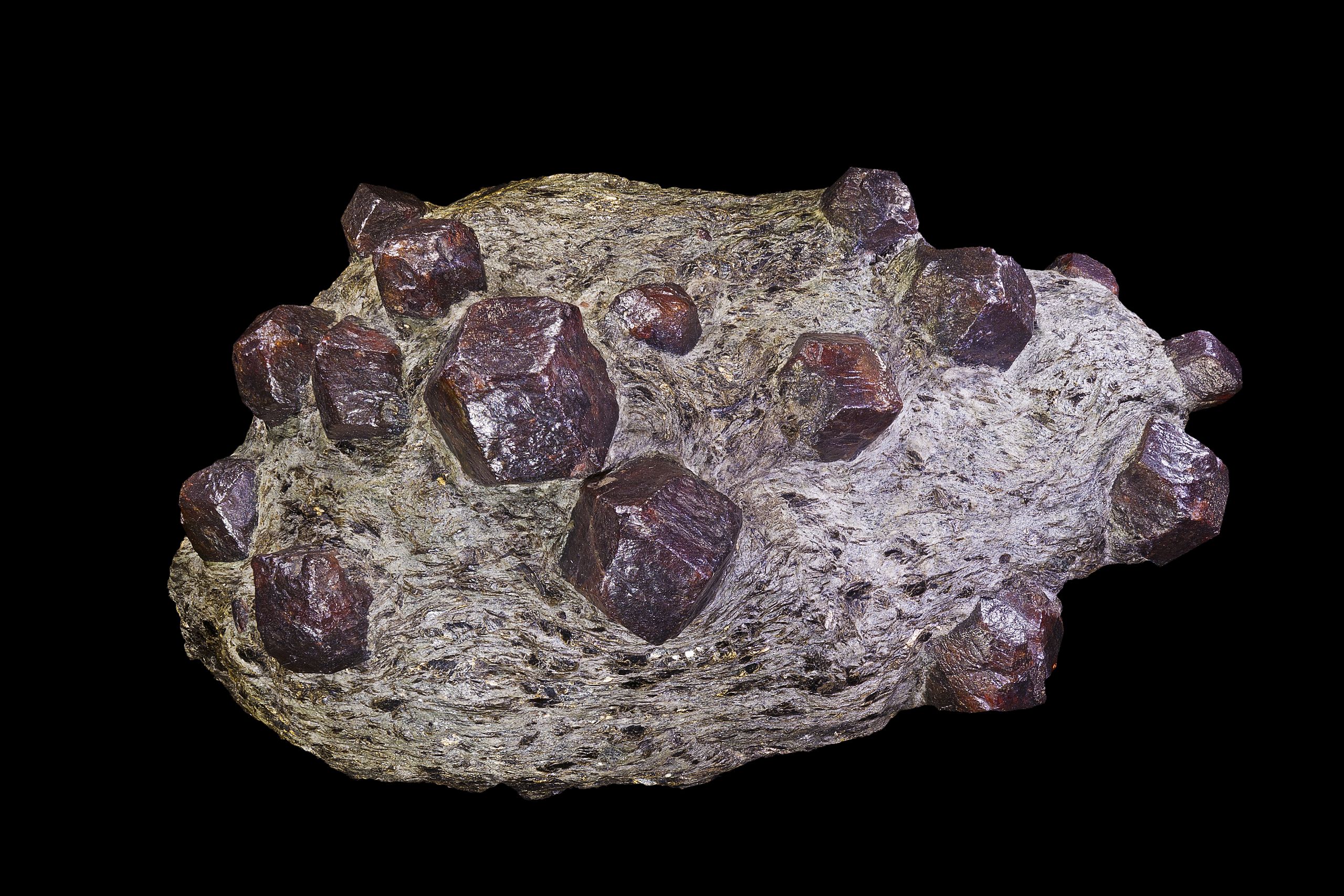
KEY CONCEPTS
- Natural systems strive for conditions of lowest energy of all sorts.
- This means that rocks undergo physical and textural changes during metamorphism that give the rocks a metamorphic fabric.
- Low-temperature metamorphic rocks typically contain small mineral grains, but with increasing grade of metamorphism, grains generally get larger.
- Many metamorphic rock contain porphyroblasts, large metamorphic crystals surrounded by a finer-grained groundmass.
- Some metamorphic rocks are foliated; the most common kinds of foliated rocks are slates, phyllites, schists, and gneisses.
- Some metamorphic rocks are nonfoliated. Many nonfoliated rocks are monomineralic, but nonfoliated metamorphic rocks may contain multiple minerals.
- The most common kinds of nonfoliated metamorphic rocks include marbles, quartzites, amphibolites, hornfels, and greenstones.
10.1 Metamorphic Fabrics
Natural systems strive for conditions of lowest energy of all sorts. If pressure or temperature change, chemical reactions generally occur to produce new metamorphic minerals and reduce chemical energy. And if a rock is subjected to pressure, mineral grains within the rock may recrystallize, reorient, move, or distort to reduce physical energy. Sometimes, platy minerals align to reduce energy caused by directed stress. Sometimes many small grains of a mineral, perhaps garnet, may combine to produce larger crystals, and thus reduce surface area and surface energy. These changes, along with others, can give a rock its metamorphic fabric, also called its metamorphic texture, and change a rock’s appearance and physical properties. Different combinations of grain sizes and shapes, and the way that mineral grains align within a rock, characterize different kinds of fabrics.
10.2 Grain Size and Porphyroblasts
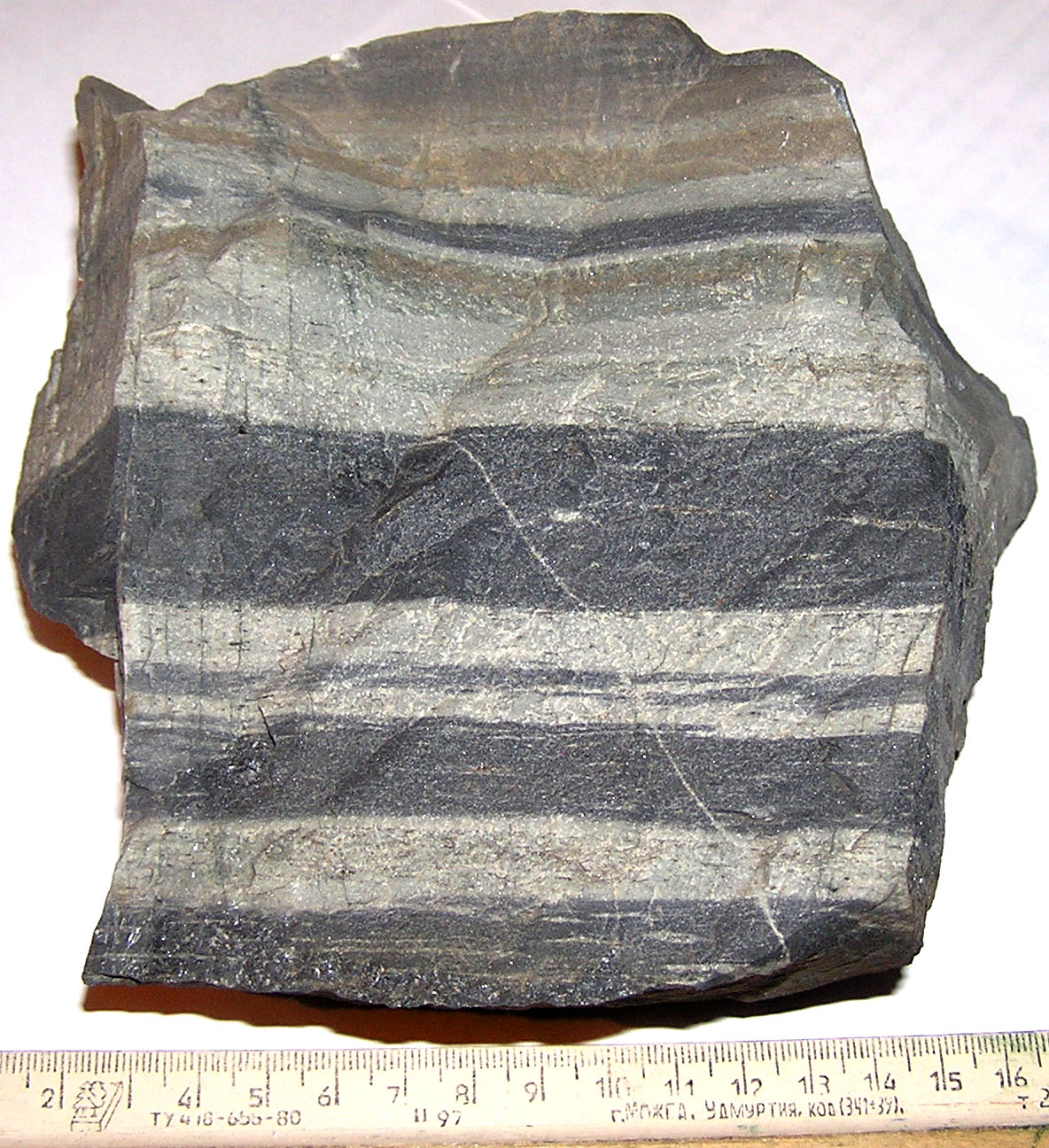
Some metamorphic rocks are so fine-grained that seeing individual mineral crystals requires a microscope. These rocks may contain no visible layering and appear as a homogeneous mass. Geologists use the general term hornfels for any fine-grained metamorphic rock that contains no visible crystals. Most hornfels are a uniform dark color, but Figure 10.1 is a sample of banded hornfels from Borok Quarry in Novosibirsk, Siberia. This metamorphic rock formed during contact metamorphism of layers of sandstone (light colored) and siltstone (dark colored), but the mineral grains in both kinds of layers are too fine-grained to see, even with a hand lens.
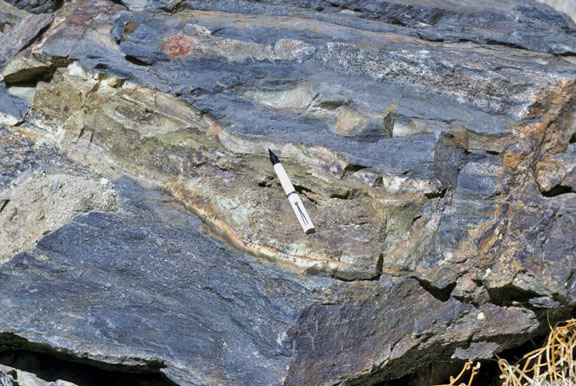
Most hornfelsic rocks are quite hard and durable because constituent grains are tightly bound together. Biotite hornfels, the most common kind of hornfels, are dark brown or gray and sometimes have a slight sheen due to the microscopic grains of biotite reflecting light (Figure 10.2). Other hornfels may have different colors; the color depends on the rock composition and whether the rock is oxidized. Some hornfels contain grains that become visible if a rock is weathered (because different minerals weather in different ways) but, because of the generally uniform rock color, are invisible otherwise.
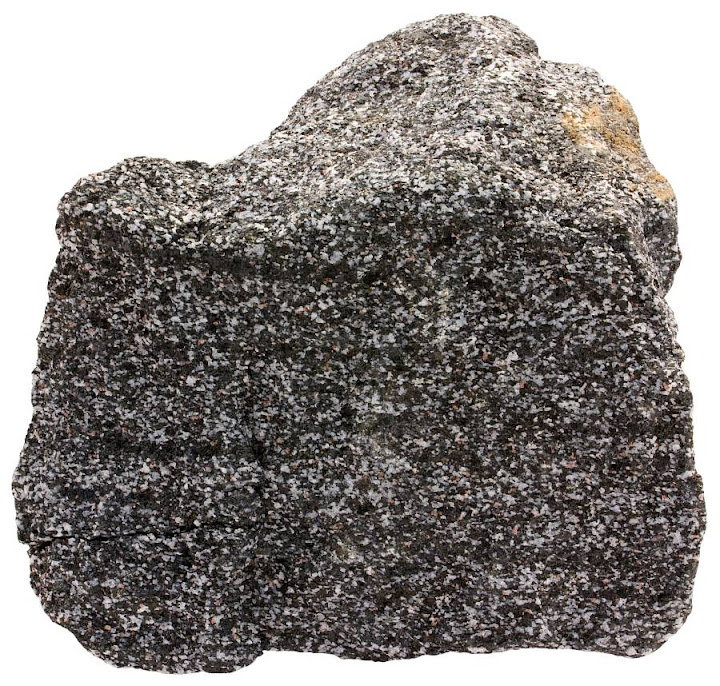
Rocks need not be exceptionally fine grained to have uniform grain size. For example, Figure 10.3 is a photo of a garnet amphibolite from Norway that contains many small visible crystals. The protolith for this rock was, most likely, a basalt. The mineral grains are equal-sized garnet, hornblende, and plagioclase crystals. Some banding (gneissic fabric) is apparent in this rock, but overall the rock has a uniform texture and small uniform grain size. Many metamorphic rocks have crystals larger than those seen in Figure 10.3. In particular, medium- and high-grade metamorphic rocks generally contain coarse mineral grains, so the garnet amphibolite (medium grade) in Figure 10.3 is a bit unusual.
Some metamorphic rocks have bimodal grain sizes, meaning that they contain mineral crystals of two distinct sizes. Such rocks, termed porphyroblastic rocks, contain large crystals surrounded by a sea of finer-grained mineral material. The finer material is the groundmass. The large crystals, called porphyroblasts, may be anhedral but are often subhedral or euhedral. Some of the most spectacular porphyroblastic rocks are mica-rich schists that contain andalusite, chloritoid, kyanite, garnet, or staurolite.
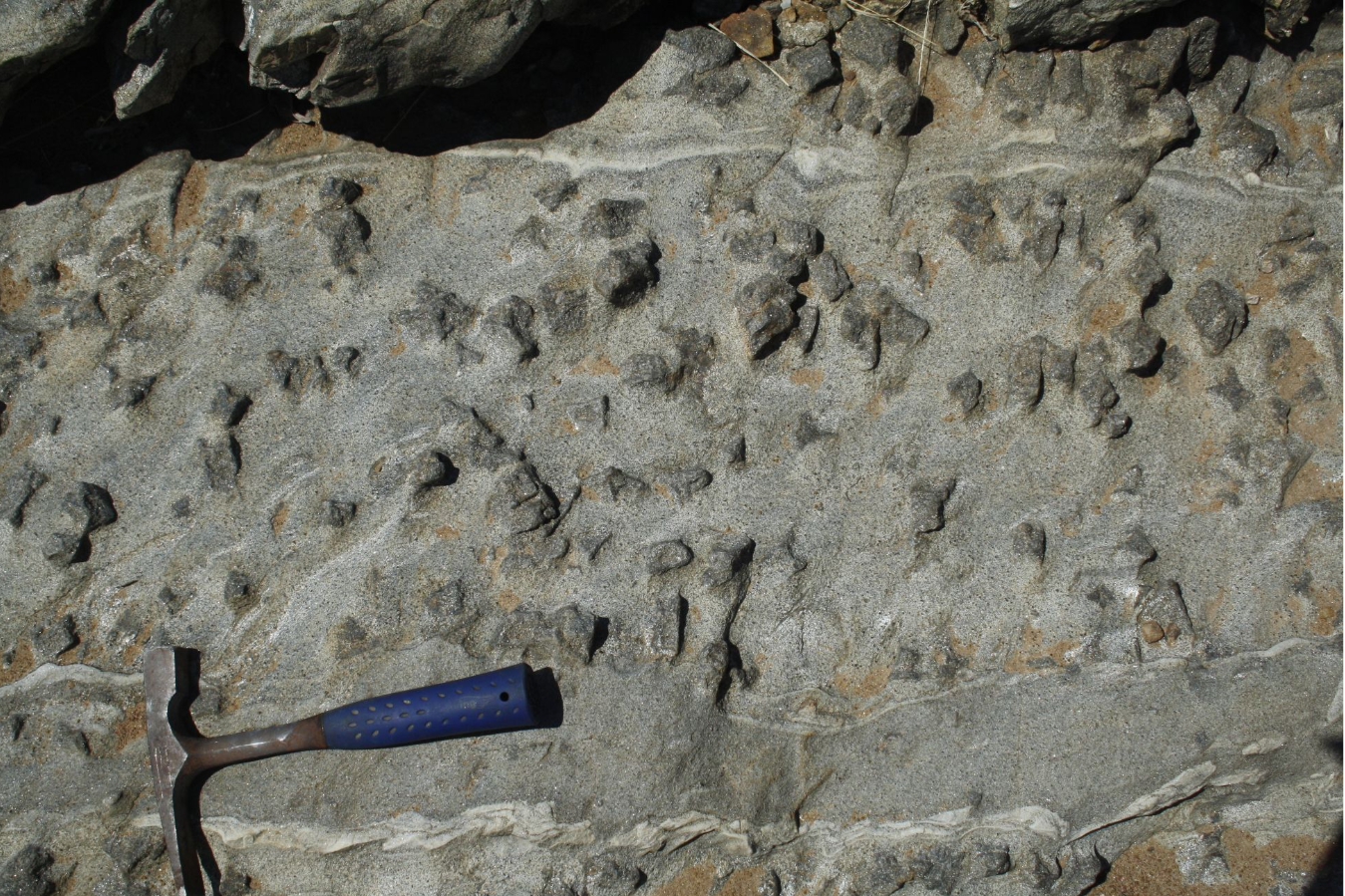
The schist seen in Figure 10.4, for example, contains large porphyroblasts of andalusite. A schist we saw in the last chapter (Figure 9.37) looks a lot like the andalusite schist seen here, but it contains coarse porphyroblasts of staurolite (instead of andalusite). Andalusite and staurolite porphyroblasts sometimes appear quite similar if they are not euhedral. Both schists have a fine-grained mica-rich groundmass around the larger crystals.
Some low-grade rocks contain only microscopic mineral grains, but large mineral crystals are generally more stable than small crystals. This is because large crystals have lower surface area to volume ratios, and mineral molecules on crystal surfaces are less stable than those entirely within a crystal. Natural systems tend to move toward conditions of lowest energy. So, with any significant amount of metamorphism, microscopic grains combine to produce fewer, but larger, visible (macroscopic) grains. Simultaneously, already visible grains grow larger. We call these observations, together, Ostwald ripening, first described by chemist Wilhelm Ostwald in 1896. We discussed Ostwald ripening briefly in Chapter 4 (Section 4.5.2.1) when we considered mineral crystallization from a magma. One consequence of Ostwald ripening is that high-grade metamorphic rocks commonly develop very large mineral crystals.

Figure 10.4, above, shows andalusite porphyroblasts in a schist. Figure 10.5 is another photo showing porphyroblasts – garnet porphyroblasts in a schist outcrop on Syros, one of the western Greek islands. Contrast the garnets in this rock with the ones seen (or not seen) in Figure 10.3. The largest of the porphyroblasts in this Syros schist are about 2 cm across.
Garnet is a very common porphyroblast in rocks metamorphosed at medium- to high-temperature. In such rocks, garnet crystals are commonly euhedral to subhedral like the crystals seen here (Figure 10.5). The groundmass surrounding the garnets in this photo is mostly muscovite with lesser amounts of quartz and feldspar. The photo of a garnet amphibolite in the previous chapter (Figure 9.29) shows large garnet prophyroblasts surrounded by hornblende and plagioclase of medium grain size.
Figure 10.6 is a photo of schist from southern Switzerland, near the Italian border. The schist contains blade-shaped porphyroblasts of kyanite (blue) and staurolite (brown). In this photo, the largest of the blue kyanite blades are about 4 cm long. In this rock, a silvery mica called paragonite makes up most of the groundmass. Paragonite is about the same as muscovite, except that sodium replaces much of the potassium in muscovite. Figure 10.7 is a photo of a different kyanite schist – one with 1-2 cm long kyanite porphyroblasts surrounded by biotite.
10.3 Lineations and Foliations
10.3.1 Lineated Metamorphic Rocks
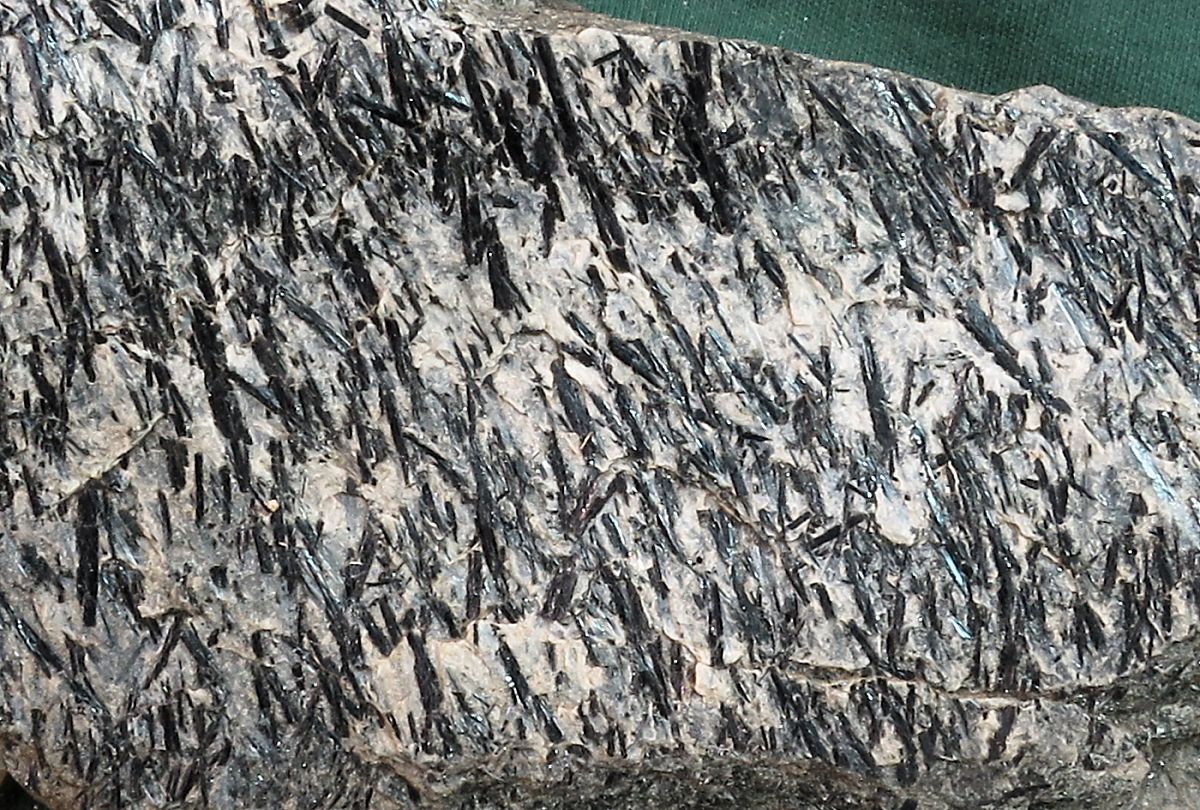
Metamorphic lineations develop when long narrow crystals line up, similar to what happens if you hold a bunch of sticks or pencils together in your hand. Figure 10.9 shows an example of a lineated rock, a hornblende schist. The black crystals are needle-like hornblende crystals in subparallel alignment. Lineations typically form parallel to directed stress or shearing. Because they form in response to directed stress, they may not be parallel to original rock bedding. Besides hornblende, tourmaline and sometimes other minerals, and stretched quartz grains or pebbles, can create a lineation.
10.3.2 Foliated Metamorphic Rocks
Some metamorphic rocks are foliated. Foliated rocks have visible repetitive parallel to sub-parallel layers that may be as thin as a flake of mica, or may be meters thick. Foliated rocks are common in mountain belts where tectonic movements compress or stretch geological terranes. Most foliations are oriented perpendicular to the direction of maximum stress that was present during metamorphism. However, if foliation develops when a rock shears, it will be parallel to the direction of shearing.

Some rocks develop slaty cleavage – a kind of foliation that manifests itself as a preferred direction of cleavage due to alignment of microscopic minerals. These minerals are typically clays, chlorite or sericite. In the slate seen on the left in Figure 10.10, the slaty cleavage is oriented vertically.
A related kind of foliation develops in schists. Schistosity involves macroscopic platy minerals, such as micas, graphite, or talc, that are aligned in a parallel manner. Rocks that contain these minerals may not, however, develop schistosity if they formed under conditions with no directed stress. Sometimes the mineral grains causing schistosity are small, sometimes quite large, but always they can be seen (in contrast with the minerals that cause slaty cleavage). Still other foliations, gneissic foliations, involve minerals separating into layers of different compositions and colors.
Lineation and foliation occur together in some rocks, but not in all. When they occur together, the direction of lineation commonly lies within foliation planes. Because foliations, like lineations, develop in response to directed stress, they may not be parallel to rock bedding. The drawing on the right in Figure 10.10 highlights the foliation that cuts across a bedding plane in the sample.
Metamorphic protoliths vary greatly in composition, and some develop foliations more than others because of their mineral constituents. If clays or micas, for example, are in a rock, they can align to produce a foliated fabric. However, if only quartz or feldspar are present, such as in a metamorphosed granite, the mineral grains are too equant and noticeable alignment may not occur. Clay and mud-rich rocks, generally called pelites by petrologists, more than any other kinds of rocks, tend to develop pronounced foliations of several kinds.
The four most common types of foliated rock, in order of increasing metamorphic grade are slate, phyllite, schist, and gneiss. These four different kinds of rocks all contain different metamorphic minerals and fabrics and vary depending on their protolith compositions. We discuss each in more detail below.
10.4 Foliated Metamorphic Rocks
10.4.1 Slate
|
|
|
Figures 10.11 and 10.12 are photos of slate. Slates contain aligned fine-grained clay minerals, chlorite, and sometimes micas. Slates form by metamorphism of shale derived by lithification of clay-rich sediments (pelites) or volcanic ash. Metamorphism generally obliterates the original bedding as foliation develops perpendicular to the direction of maximum stress. This foliation, slaty cleavage, gives slates a property called fissility – an ability to break into thin sheets of rock with flat smooth surfaces (called parting surfaces). The minerals in the rock seen in Figure 10.11 cannot be identified in hand specimen, but in thin section we can identify clay, quartz, chlorite, and muscovite. These are typical minerals in slate.
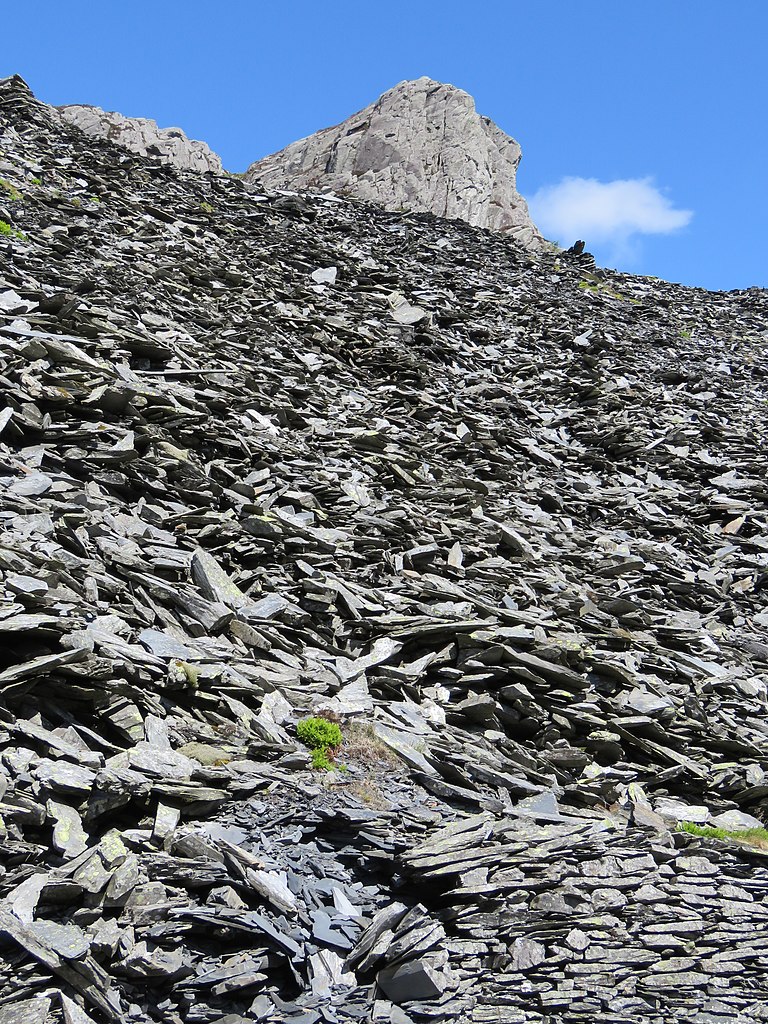
Slate is generally dark black, gray, or greenish-gray, sometimes reddish (Figure 10.12) and may look somewhat like shale. Some petrologists distinguish slate from shale by the sound made when they tap a rock with a hammer. Mineral grains in slate are harder and better cemented together than grains in shale. So, when struck, slate produces a ringing or pinging sound, in contrast with shale’s thud. Figure 10.13 is a view of a slate at a quarry in Wales. The individual pieces are all several centimeters thick with parallel sides. Quarrying slate is an inefficient process. Most quarry operations produce more waste rock than high-quality commercial rock.
10.4.2 Phyllite
|
|
|
Phyllite, another fine-grained dark-colored metamorphic rock, is quite similar to slate but forms at slightly higher metamorphic grade. The rocks seen in Figures 10.15 and 10.16 are two examples.
Foliation in phyllites is due to parallel alignment of very small – mostly microscopic – muscovite, chlorite, or other micas, sometimes with graphite. Clays are absent. Thus, foliation of phyllites is different from the foliation in slates that stems mostly or in-part from clay mineral alignment, and different from foliation in schists because schists always contain macroscopic (visible) mica mineral grains. Commonly, foliated layers in phyllites are not planar, and rocks may have a wavy surface such as seen in Figure 10.15, or a rippled surface such as seen below in Figure 10.17. Like slates, phyllitic rocks exhibit fissility, the ability to be cleaved into thin parallel layers.

Sometimes phyllites contain very small visible mineral crystals. Often, however, the only thing distinguishing phyllite from slate is that the fine-grained micas and graphite, which are too small to see without a microscope, give phyllites a silky/shiny appearance, or sheen, called a phyllitic luster. This sheen, visible in Figures 10.15, 10.16, and 10.17, is present because the mica and chlorite grains are coarser in phyllite than in slate.
Phyllitic luster – which is absent from slate and schist – really defines a phyllite. Additionally, phyllites commonly lack the perfect parallel cleavage that characterizes slate. Like slate, phyllite forms by metamorphism of shales or mudstones, and less commonly by metamorphism of volcanic rocks.
10.4.3 Schist
Aligned platy macroscopic minerals, generally micas, may give a rock schistosity. This property allows a rock to be cleaved (broken easily in one direction but not in other directions). Schists are a medium-grade metamorphic rocks that form at higher grade than phyllites. Like phyllites, most common schists have a pelitic protolith. Most schists form when phyllites are further metamorphosed.
|
|
|
Large highly-reflective aligned mica crystals, easily seen with the naked eye, characterize the vast majority of schists. Muscovite and biotite schists are the common kinds – Figure 10.18 is an example of a muscovite schist from the Black Hills that contains mostly silvery muscovite with small black crystals of hornblende. The view in this figure is perpendicular to the schistosity. Figure 10.19 is a biotite schist containing mostly black biotite, quartz, and feldspar. If you look closely you can see small blue crystals of kyanite that are also present.

Quartz and feldspar are present in mica schists, often deformed or elongated parallel to the micas, and many other minerals are possible. Due to deformation during metamorphism, many schists contain wavy, instead of completely parallel, sheets of mica. You can see a hint of this in Figure 10.18. Most schists get their schistosity from aligned micas, but graphite, talc, chlorite, and hornblende schists are common. Figure 10.20 is a photo of a talc schist.
Schist ranges from being relatively fine-grained to coarse-grained. Coarse-grained schists, such as the biotite schist in Figure 10.19 and the talc schist in Figure 10.20, have an especially shiny reflective luster. The schist in Figure 10.20 is made entirely of parallel sheets of talc, but many schists contain multiple minerals and sometimes porphyroblasts.
If schistose rocks contain prominent porphyroblasts, we name them accordingly. For example, Figure 10.21 is a photo of a garnet schist and Figure 10.22 is a photo of a kyanite schist. The finer-grained material around the porphyroblasts is mostly muscovite and biotite in both photos. Figure 10.4 and Figure 10.6 (earlier in this chapter) are an andalusite schist and a kyanite-staurolite schist. Figure 9.37 from the previous chapter is a staurolite schist.
|
|
|
Foliation in most schists is attributable to sheet silicates including talc, muscovite, biotite. Figure 10.22 is a different kind of schist, a kyanite schist. Foliation in this rock is due mostly to parallel alignment of blue kyanite blades instead of being caused by micas. The opening photo in Chapter 9 is a photo of a different kyanite schist – one containing large garnet and kyanite crystals.
Figures 10.23 and 10.24, below, are photos of a greenschist and a blueschist. These kinds of rocks are in many ways similar to more common schists. Greenschists and a blueschists exhibit some degree of schistosity, but typically not as pronounced as in mica schists. Commonly, they lack obvious coarse mica crystals like many schists do. Greenschists, which are low-grade metamorphic rocks, are green because they contain chlorite, and perhaps other green minerals including epidote, actinolite, or serpentine. Quartz, feldspar, talc, muscovite, and carbonate minerals are sometimes present too.
Blueschists, such as the one above (Figure 10.24) are relatively rare high-pressure rocks that get their blue-gray color from blue amphibole, generally glaucophane or riebeckite. The blueschist seen in Figure 10.24 contains garnet, but not all blueschists do. We will talk more about greenschists and blueschists later in Chapters 13 and 14.
10.4.4 Gneiss
Gneisses, the highest temperature-pressure kinds of foliated metamorphic rock, typify many regions that have undergone high-temperature metamorphism. The defining characteristics of most gneisses, such as the ones in the four figures below, are that the rocks are medium- to coarse-grained and contain layers of light and dark-colored minerals that give the rock foliation called gneissic banding. Sometimes the banding in gneisses is deformed a little (Figure 10.25) or a great deal (Figure 10.28).
|
|
|
Gneissic banding most commonly forms in response to directed stress, although, sometimes, layering may form solely due to chemical processes that concentrate different minerals in different layers. Felsic light-colored layers typically contain quartz and feldspars, and more mafic darker layers typically contain biotite, hornblende, or pyroxene. Other accessory minerals, such as garnet, are common. The gneiss in Figure 10.28, a deformed granitic gneiss from the Czech Republic, contains pink K-feldspar rich layers alternating with darker layers that contain biotite.
We often name gneisses based on their protoliths, and petrologists use the general terms orthogneiss for gneisses derived from igneous rocks (such as the gneiss in Figure 10.25), and paragneiss for gneisses derived from sedimentary rocks. More specific names abound – for example, pelitic gneisses, form by metamorphism of clay-rich sedimentary rocks. Granitic gneisses (Figures 10.26 and 10.27) form by metamorphism of granites, and mafic gneisses (Figure 10.25) form by metamorphism of mafic igneous rocks. Sometimes we include key minerals in rock names. For example, a garnet-sillimanite gneiss is a gneiss that contains conspicuous garnet and sillimanite crystals.
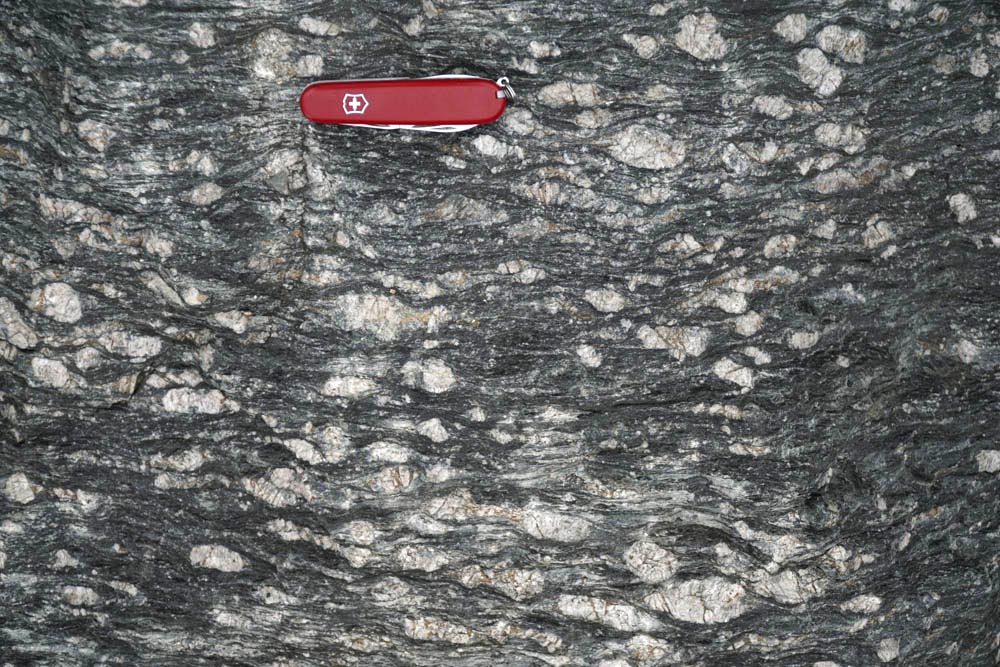
Some gneisses do not display well-defined dark- and light-colored banding but still maintain less distinct foliation. For example, the foliation in a kyanite gneiss may come from alignment of light-blue kyanite crystals in an otherwise quartz- and muscovite-rich rock. And an augen gneiss, such as the rock seen here (Figure 10.29), contains large feldspar crystals – “eyes” (augen is German for eyes) – stretched in one direction. In Figure 10.29, the sample is oriented so the stretch direction (and, thus, the foliation) is horizontal.
10.4.5 Flat-Pebble Conglomerate

A different, and unique, kind of foliated metamorphic rock forms when a conglomerate experiences directed stress that flattens individual clasts in the rock, creating a flat-pebble conglomerate like the one seen in Figure 10.30. If a sample of “unstretched” rock is available, the clast shapes and dimensions provide a record of how much the rock was stretched, and the orientation of the clasts records the direction of maximum stress.
10.5 Nonfoliated Metamorphic Rocks
Nonfoliated rocks, also described as massive rocks, lack a parallel arrangement of minerals and have uniform properties in all directions. Generally, massive rocks do not contain micas or other minerals that could create a foliation. In these rocks, individual mineral grains or crystals, which may start small, commonly recrystallize and grow together during metamorphism to produce larger crystals. If the mineral grains are visible and all about the same size, we describe the rocks as granoblastic, and we call the rocks granofels. In the most well-formed granofels, mineral grains are equant instead of euhedral, and mineral grains intersect at triple junctions with grain boundaries creating 120o angles that we can see in thin section. The most common granoblastic rocks are quartzites (composed mostly of quartz), marbles (composed mostly of calcite or dolomite), and hornfels. Figures 10.31 and 10.32 show examples of quartzite and marble.
|
|
Quartzites and limestones are generally monomineralic, but, nonfoliated metamorphic rocks may contain multiple minerals. For example, the eclogite in Figure 10.33 contains conspicuous red garnet and blue kyanite, along with green pyroxene and milky quartz. No foliation is present.
10.5.1 Marbles
Figure 10.32 is a photo of an 8-cm wide massive rock consisting only of coarse blue calcite. This rock, which comes from the Valentine Mine in the western Adirondack Mountains, New York, derived from a limestone protolith. Petrologists use the term marble for all rocks created by metamorphism of limestones or dolostones. (This sometimes leads to confusion because builders and others use the same term to describe any polished slab of rock.) Marbles generally lack any sort of foliation. Figure 9.18 is a photo of people on a large outcrop of marble in Montana.
Most marble protoliths have relatively simple chemistry; they are limestones and contain primarily calcite (CaCO3) or dolomite(CaMg(CO3)2), or both. If the protolith contains some quartz, metamorphism may produce Ca- and Ca-Mg silicate minerals such as wollastonite (CaSiO3) or diopside (CaMgSi2O6). And, sometimes, grossular (a Ca-rich garnet), vesuvianite, or other Al-bearing minerals may be present as well. The aluminum, necessary for these minerals to form, comes from small amounts of clay in the parent rocks or is introduced by metasomatism. We explore these possibilities more fully in Chapter 15.

Figure 10.32 is a photo of a marble made entirely of calcite. Figure 10.34 is a different marble from the western Adirondacks, from another site near the Valentine Mine. It contains dark-green diopside besides white calcite. (Calcite in most marbles is white, as in this sample, not blue like the calcite in the marble seen in Figure 10.32.) The limestone protolith for the rock seen in this limestone (Figure 10.34) contained some quartz (SiO2) that reacted with dolomite (Ca-Mg carbonate) during metamorphism, producing the diopside (Ca-Mg silicate). Other Ca- and Mg-silicates may also form during metamorphism of limestone that contains quartz.
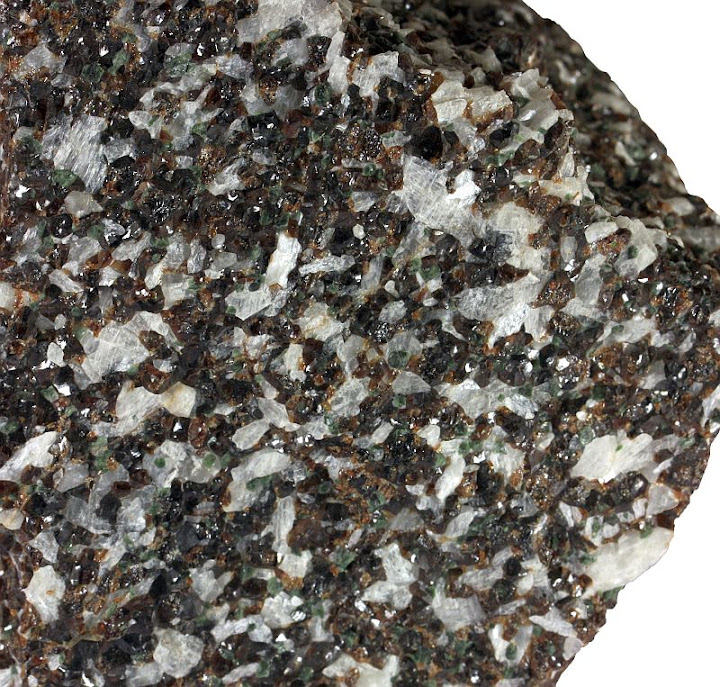
When metamorphosed, some impure limestones and dolostones lose all or most of their original carbonate minerals. The calcite or dolomite once present reacts to form other, non-carbonate minerals. We call such rocks calcsilicate rocks, or just calcsilicates. These rocks typically contain diopside, garnet, or wollastonite, but other minerals are possible. Figure 10.35 is an example that contains prominent garnet and white wollastonite, with lesser amounts of small diopside crystals. Often the formation of calcsilicate rocks such as the one in Figure 10.35 involves significant amounts of metasomatism. We will look closer at calcsilicate rocks and metasomatism in Chapter 15.
10.5.2 Quartzites
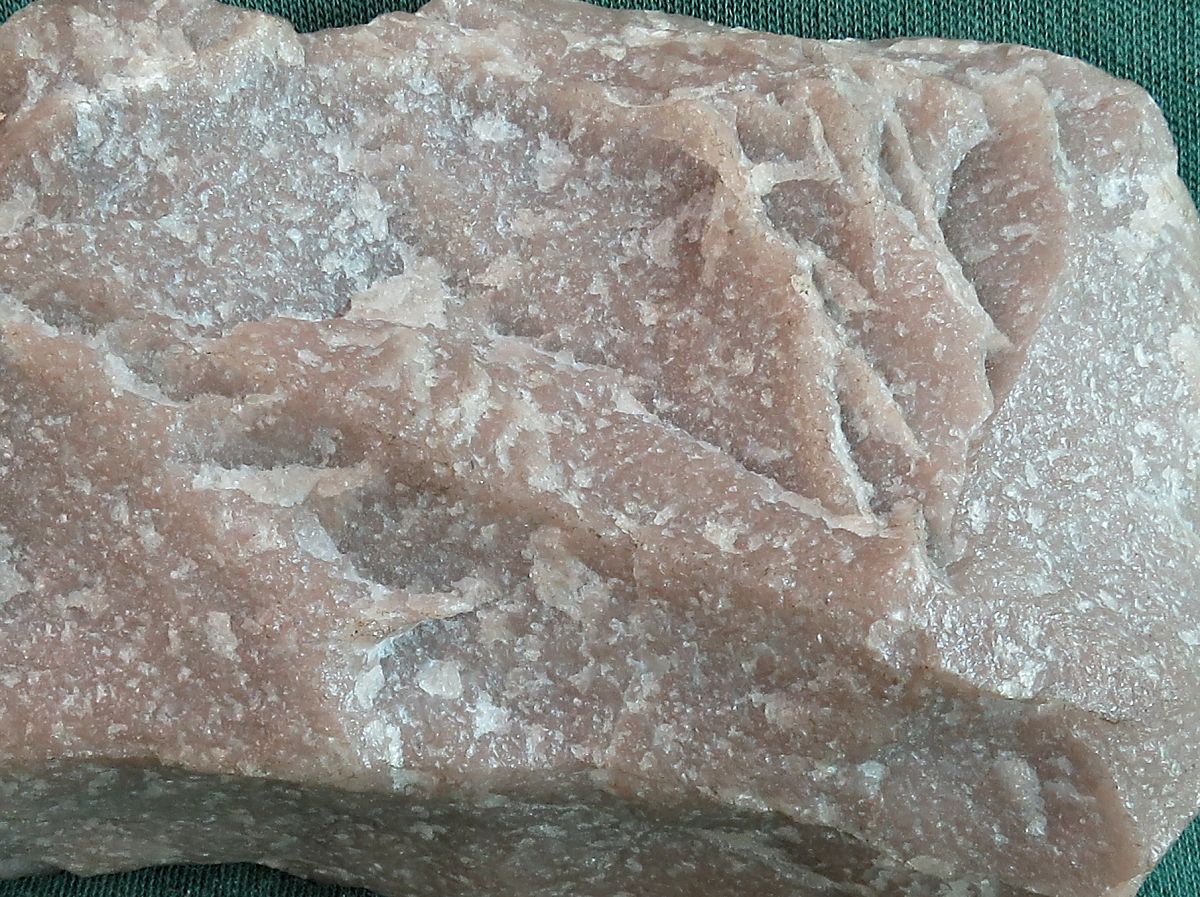
Quartzites form by metamorphism of sandstone, and most sandstones are mainly quartz. (Creating some confusion, sedimentary petrologists use the name quartzite to describe a sandstone made entirely of quartz that has not undergone metamorphism.) Figure 10.36, a typical metamorphic quartzite, is composed entirely of millimeter-sized quartz crystals that have grown together so that no grain boundaries are visible without a microscope. Recrystallization has produced a typical hard and shiny quartzite rock, and metamorphism has erased any original sedimentary textures. Quartz grains are so tightly bonded that when quartzite breaks, it forms irregular conchoidal fractures.
Common quartzites are white or gray, but minor components may add color. Figures 10.31 and 10.32 are typical examples. If a quartzite’s protolith sandstone contained minerals besides quartz, the product quartzite will too. Thus, feldspar, titanite, rutile, magnetite, or zircon may be present in small amounts. And, if the protolith contained some clay, aluminous minerals such as kyanite may also be present. The pink color seen in Figure 10.36 probably comes from hematite that was in the cement that held the sandstone together.
10.5.3 Amphibolites
Figure 10.37 is a photo of an amphibolite outcrop. From a distance, this rock is dark colored and nondescript. Figure 10.38 is a closer view of a nondescript amphibolite. Many amphibolites are non-foliated and have this homogeneous and massive appearance. Figure 10.39, however, is a hand specimen of a garnet amphibolite, reminding us that amphibolites need not be nondescript and that they may be foliated. Amphibolites form by metamorphism and recrystallization of basalt or other mafic igneous rocks. All amphibolites contain mostly hornblende and plagioclase, but other minerals including garnet and minor quartz are typically present. In Figure 10.39, the garnet porphyroblasts, 1-2 cm wide, are large and conspicuous. Sometimes when garnet is present in an amphibolite, it is more difficult to see, such as in the amphibolite in Figure 10.3. Although some amphibolites are strongly foliated, most are not. When foliation is present, it is usually not well developed. The garnet amphibolite seen in Figure 10.39 is an exception. See Figure 9.4 for an example of a rock that contains the same minerals but shows no foliation.
|
|
|
|
10.5.4 Hornfels and Greenstones
Hornfels, mentioned earlier in this chapter, and greenstones are also kinds of nonfoliated metamorphic rocks. As defined at the start of this chapter, geologists use the name hornfels for any dark-colored, nonfoliated, fine-grained metamorphic rock. Greenstones, which are a specific kind of hornfels, form by metamorphism of basalts. Figures 10.40 and 10.41 are photos of hornfels derived from a sedimentary protolith. Figure 10.42 is a sample of greenstone from near Ely, Minnesota. The greenish color is due to chlorite and epidote that developed during metamorphism. Figure 10.43 is an outcrop of greenstone near Ely. The rock originated as an ocean-floor basalt, and the outcrop contains pillows indicative of submarine eruption.
10.5.5 Anthracite

Anthracite (Figure 10.44) provides another example of a nonfoliated metamorphic rock. Anthracite is a type of very high-rank coal. All coal has a sedimentary origin, but anthracite is metamorphosed coal that forms in mountain belts when metamorphic temperatures exceed about 200 oC. Under such conditions, organic materials break down and coal loses water and other volatile compounds. The coal becomes hard and compact as it turns into anthracite, typically containing graphite as its main mineral.
● Figure CreditsUncredited graphics/photos came from the authors and other primary contributors to this book. 10.0 (opening photo) Garnet schist, Didier Descouens, Wikimedia Commons |

